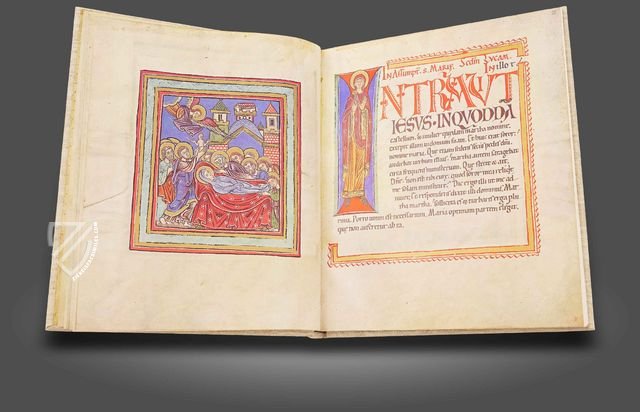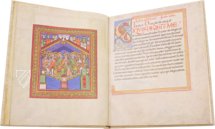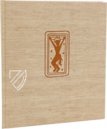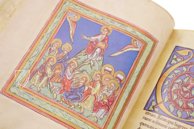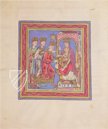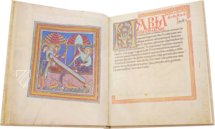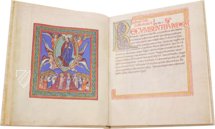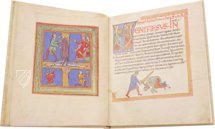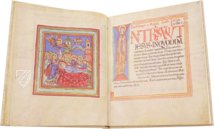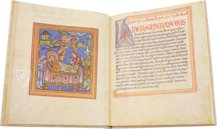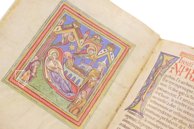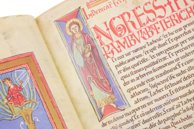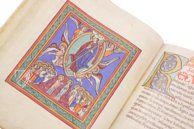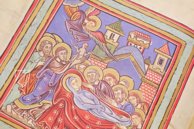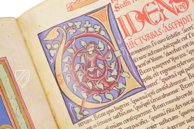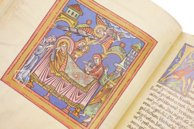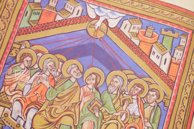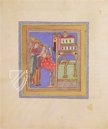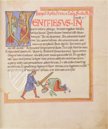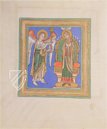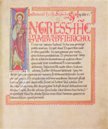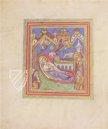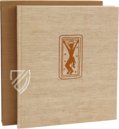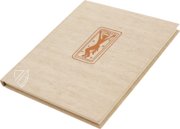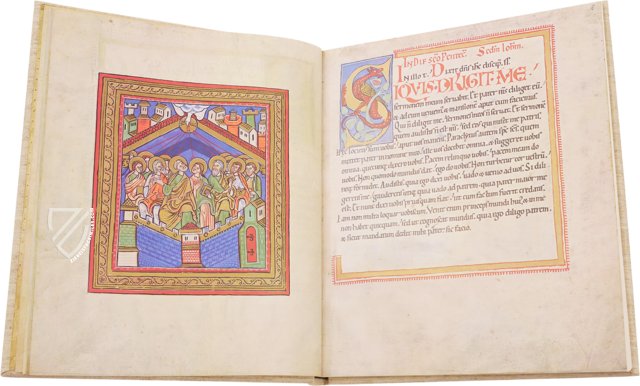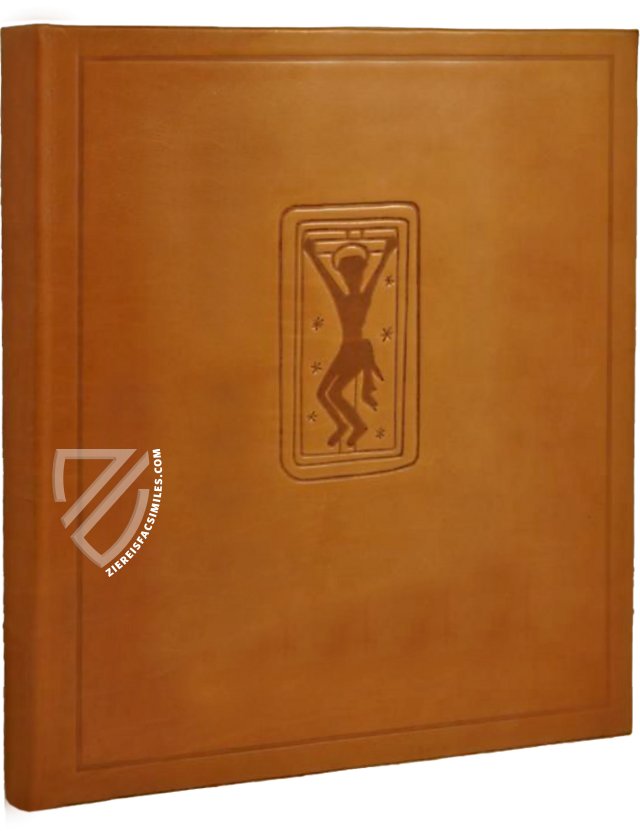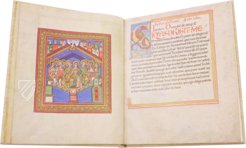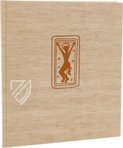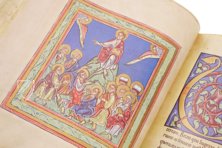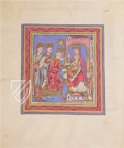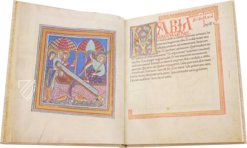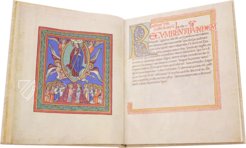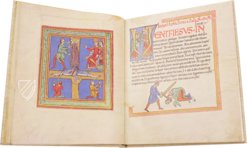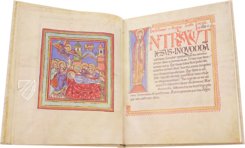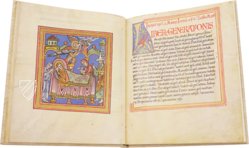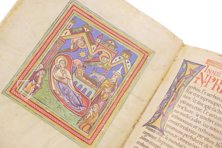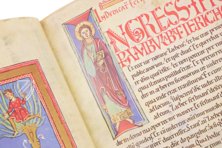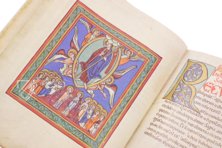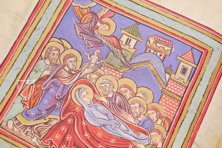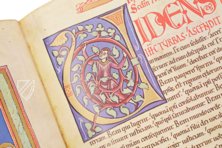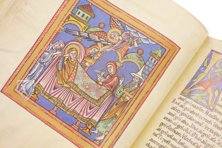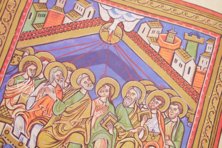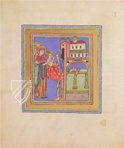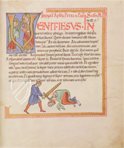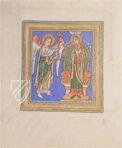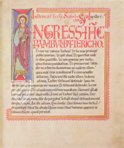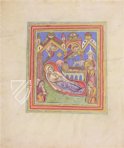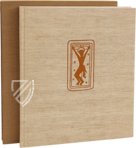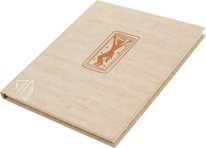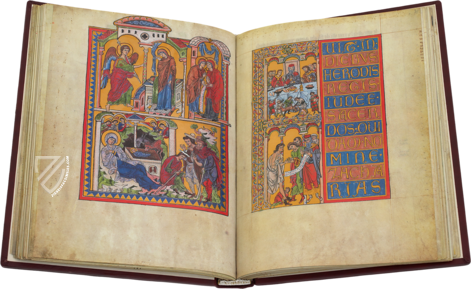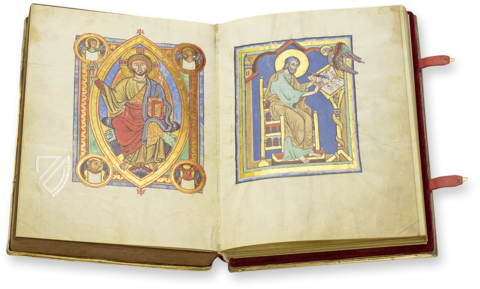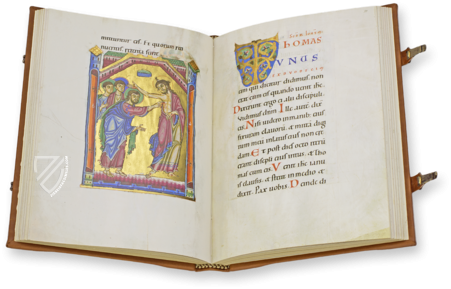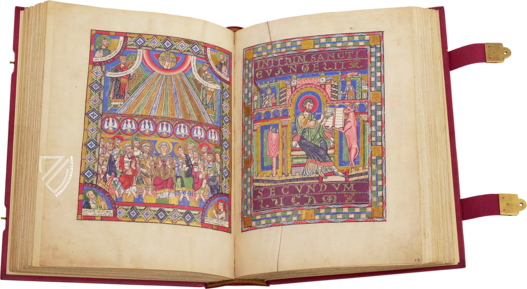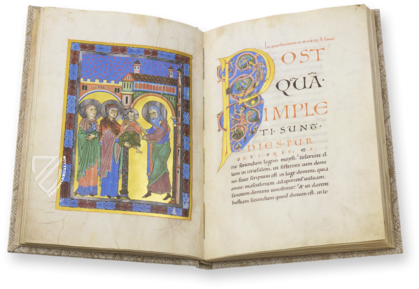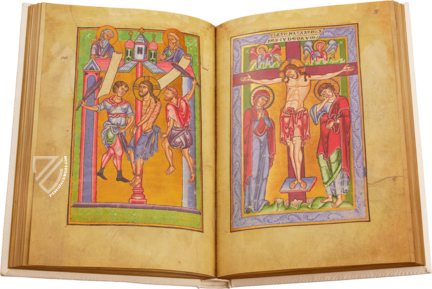Gospel Lectionary from Saint Peter in the Black Forest
(under 1,000€)
The Abbey of Saint Peter in the Black Forest is a former Benedictine monastery founded ca. 1073 that moved twice before being settled at its current site near Freiburg ca. 1090. Thanks to numerous donations of money and land, St. Peter’s grew wealthy, which is evidenced by the sumptuous and sophisticated illumination of the Romanesque manuscript at hand. Created in an Alsatian monastery ca. 1200, evidence of the hands of two masters can be seen in the manuscript’s twelve refined and well-designed full-page miniatures set within thick patterned frames. The colors red, blue, green, and gold dominate the imagery, which features monumental and somber, yet expressive figures depicted in scenes with luminous solid blue backgrounds. Although clearly influenced by Ottonian illumination, they already exhibit characteristics of the nascent Gothic style. Twelve decorative and sometimes historiated initials with leafy vines, dragons, and human figures introduce the artfully written, red-and-gold-framed text excerpts from the Gospels.
Gospel Lectionary from Saint Peter in the Black Forest
The Gospel Book from St. Peter’s Abbey in the Black Forrest is unique among the book-type because rather than containing the liturgy for performing mass on Sundays, it is a luxury manuscript that only contained texts for the twelve most important festivals of the ecclesiastical year. It was likely intended to be displayed for the public in order to exhibit the wealth and sophistication of the monastery and its community. Each festival is richly adorned by a full-page miniature, a decorative (sometimes historiated) initial, and a gold and red frame around the text. However, gold leaf was not used to create the frames but rather a reddish shimmering gold bronze that is more subdued than the highly polished gold leaf used for the miniatures and initials. The frame thus has a restrained appearance and serves only as a companion to the text and other decorative elements. This manuscript represents a rare and wonderful blend of artistic styles from the 12th and 13th centuries.
Solving the Manuscript’s Mysterious
Like most of the 200 manuscripts that were once part of the abbey’s library, little is known about the origins of this Gospel Book and it took some detective work by researchers to determine where it was made. Elements of the manuscript such as the calendar allowed researchers to determine that it was originally created for an Alsatian monastery patronized by St. Peter and St. Paul. The only monastery in the region meeting this criteria is the Benedictine Abbey of Weißenburg, which as a Hirsau reform monastery was connected on the one hand with monasteries in the Mass-Moselle region such as Echternach, and on the other hand with the bishoprics of Speyer and Strasbourg, which explains the many artistic influences that can be seen in the Gospel Book. With the help of the calendar, it has been determined that the two strange figures in the background of the miniature for All Saints’ Day depicting the Sermon on the Mount (fol. 12v) are the Syrian saints Sergius and Bachus, martyred 4th century Roman Christian soldiers whose relics were transported from Rome to Weißenburg by Abbot Otgar (d. 847). This precious manuscript is believed to be the only surviving magnificently adorned manuscript from the scriptorium of Weißenburg Abbey.
A Mix of Styles and Influences
The splendid illumination of the manuscript exhibits influences from various sources including a book of pericopes from Paris, a missal from Mainz, the iconography of the Hortus Deliciarum, a group of ivory carvings from Cologne made during the first half of the 12th century, and the stained-glass windows of Strasbourg Cathedral, which were completed around the same time as the manuscript. Influences from the Hortus can be seen in the step motifs of approaching angels, the structure of their fall of folds, and the depiction of tiled roofs. Similarities with Strasbourg´s windows, which were themselves influenced by Byzantine mosaics and ivory panels, can be found in the elegant figures of St. John and the Judgment of Solomon. They share similar head shapes with wide eyes and noses with strong bridges, turban-like headscarves for the women, and youths with short wavy hair parted in the middle. This manuscript thus represents the best of Alsatian and Upper Rhenish art during the 12th and 13th centuries.
The Tumultuous History of St. Peter’s Abbey
St. Peter's Abbey in the Black Forest had a tumultuous 700-year-history between 1093, when it was founded, and 1806, when it was dissolved in the course of Secularization. It suffered from devastating fires in 1238 and 1437, was completely destroyed and plundered during the Thirty Years’ War, and burned again in 1678 before being rebuilt in the Baroque style. Naturally, these terrible events destroyed the abbey’s library time and again.
Construction of the present library, which was designed by Peter Thumb (1681–1767), began in the late 1730’s but was stalled for eleven years due to occupation by the French army and resistance from the peasants who were legally obligated to provide labor for its construction. However, once complete, the beautifully painted library filled with statues was considered to be one of the most beautiful Rococo rooms in the region. The art-loving bibliophile Abbot Philip Jakob Steyrer (1715–95) sought to rebuild the collection of the library, which numbered only 1,000 books when he was appointed abbot. By the time of his death, the library housed around 20,000 books and the heart of the collection consisted of 200 medieval manuscripts including this fine Gospel Book.
Codicology
- Alternative Titles
- Evangelistar aus St. Peter
Gospel Book from St. Peter’s - Size / Format
- 26 pages / 23.5 × 27.5 cm
- Origin
- France
- Date
- 1200
- Epochs
- Style
- Genre
- Language
- Script
- Gothic minuscule
- Illustrations
- 12 nearly square full-page miniatures and 12 gold-framed pages of text
Gospel Lectionary from Saint Peter in the Black Forest
The Martyrdom of Saint Paul
Various ancient sources recount how Paul the Apostle was arrested and brought to Rome in the wake of the Great Fire of Rome during the Neronian Persecution. They claim that he was beheaded like John the Baptist around the same time that Saint Peter was martyred and this is the common image of him in martyrology. A legend developed that Paul was killed at the Aquae Salviae and after he was decapitated, his severed head bounced three times and water rose from wherever it touched the ground. Today this place is marked by a church known as San Paolo alle Tre Fontane or “St Paul at the Three Fountains”.
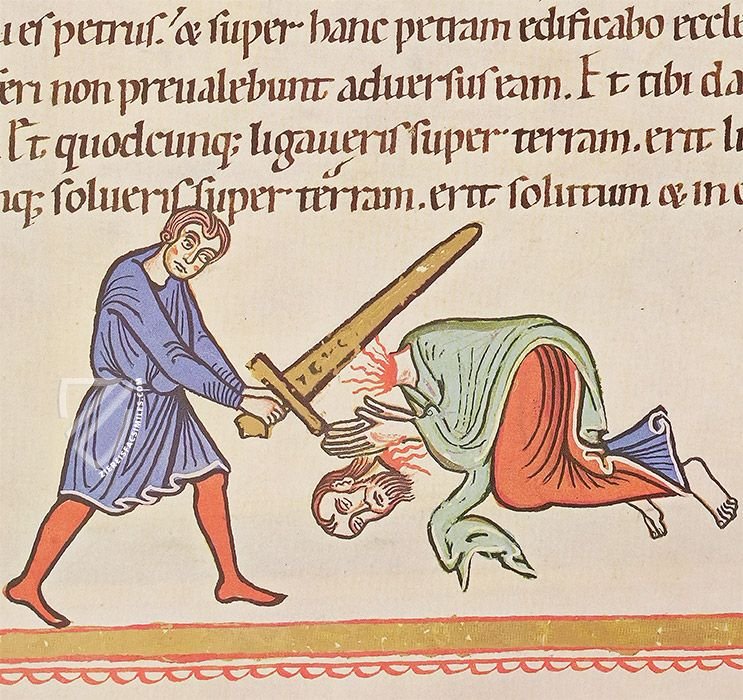
Gospel Lectionary from Saint Peter in the Black Forest
The Nativity
Labelled In Nativitate Domini on the opposite page, as are all the miniatures in this work, this fine miniature shows the Holy Family accompanied by three additional female figures, probably relatives or midwives who assisted in the birth. Joseph is depicted wearing a pointed Jewish hat while all the figures have exhausted expressions on their face with eyes that they can barely hold open.
In order to depict the cow and donkey lying next to the manger in this crowded composition, the artist drew them floating behind it almost as though they were resting their heads on the sides. Two angels appear under the arches of the creatively designed architectural background and point to the newborn Messiah. Although the Three Kings have not arrived yet, the star that guides them glimmers in the distance.
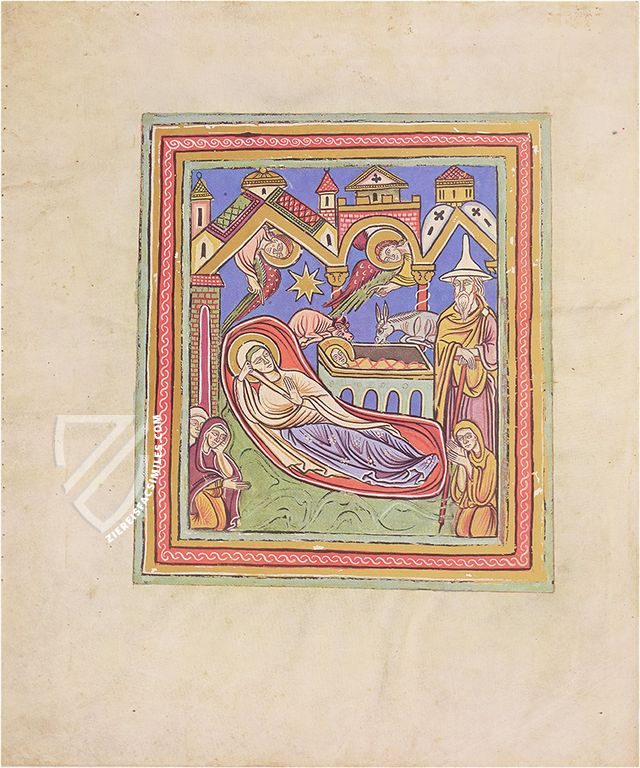
#1 Das Evangelistar aus St. Peter (Standard Edition)
Language: German
(under 1,000€)
#2 Das Evangelistar aus St. Peter (Luxury Edition)
- Treatises / Secular Books
- Apocalypses / Beatus
- Astronomy / Astrology
- Bestiaries
- Bibles / Gospels
- Chronicles / History / Law
- Geography / Maps
- Saints' Lives
- Islam / Oriental
- Judaism / Hebrew
- Single Leaf Collections
- Leonardo da Vinci
- Literature / Poetry
- Liturgical Manuscripts
- Medicine / Botany / Alchemy
- Music
- Mythology / Prophecies
- Psalters
- Other Religious Books
- Games / Hunting
- Private Devotion Books
- Other Genres
- Afghanistan
- Armenia
- Austria
- Belgium
- Belize
- Bosnia and Herzegovina
- China
- Colombia
- Costa Rica
- Croatia
- Cyprus
- Czech Republic
- Denmark
- Egypt
- El Salvador
- Ethiopia
- France
- Germany
- Greece
- Guatemala
- Honduras
- Hungary
- India
- Iran
- Iraq
- Israel
- Italy
- Japan
- Jordan
- Kazakhstan
- Kyrgyzstan
- Lebanon
- Liechtenstein
- Luxembourg
- Mexico
- Morocco
- Netherlands
- Palestine
- Panama
- Peru
- Poland
- Portugal
- Romania
- Russia
- Serbia
- Spain
- Sri Lanka
- Sweden
- Switzerland
- Syria
- Tajikistan
- Turkey
- Turkmenistan
- Ukraine
- United Kingdom
- United States
- Uzbekistan
- Vatican City
- A. Oosthoek, van Holkema & Warendorf
- Aboca Museum
- Ajuntament de Valencia
- Akademie Verlag
- Akademische Druck- u. Verlagsanstalt (ADEVA)
- Aldo Ausilio Editore - Bottega d’Erasmo
- Alecto Historical Editions
- Alkuin Verlag
- Almqvist & Wiksell
- Amilcare Pizzi
- Andreas & Andreas Verlagsbuchhandlung
- Archa 90
- Archiv Verlag
- Archivi Edizioni
- Arnold Verlag
- ARS
- Ars Magna
- ArtCodex
- AyN Ediciones
- Azimuth Editions
- Badenia Verlag
- Bärenreiter-Verlag
- Belser Verlag
- Belser Verlag / WK Wertkontor
- Benziger Verlag
- Bernardinum Wydawnictwo
- BiblioGemma
- Biblioteca Apostolica Vaticana (Vaticanstadt, Vaticanstadt)
- Bibliotheca Palatina Faksimile Verlag
- Bibliotheca Rara
- Boydell & Brewer
- Bramante Edizioni
- Bredius Genootschap
- Brepols Publishers
- British Library
- C. Weckesser
- Caixa Catalunya
- Canesi
- CAPSA, Ars Scriptoria
- Caratzas Brothers, Publishers
- Carus Verlag
- Casamassima Libri
- Centrum Cartographie Verlag GmbH
- Chavane Verlag
- Christian Brandstätter Verlag
- Circulo Cientifico
- Club Bibliófilo Versol
- Club du Livre
- CM Editores
- Collegium Graphicum
- Collezione Apocrifa Da Vinci
- Comissão Nacional para as Comemorações dos Descobrimentos Portugueses
- Coron Verlag
- Corvina
- CTHS
- D. S. Brewer
- Damon
- De Agostini/UTET
- De Nederlandsche Boekhandel
- De Schutter
- Deuschle & Stemmle
- Deutscher Verlag für Kunstwissenschaft
- DIAMM
- Droz
- E. Schreiber Graphische Kunstanstalten
- Ediciones Boreal
- Ediciones Grial
- Ediclube
- Edições Inapa
- Edilan
- Editalia
- Edition Deuschle
- Edition Georg Popp
- Edition Leipzig
- Edition Libri Illustri
- Editiones Reales Sitios S. L.
- Éditions de l'Oiseau Lyre
- Editions Medicina Rara
- Editorial Casariego
- Editorial Mintzoa
- Editrice Antenore
- Editrice Velar
- Edizioni Edison
- Egeria, S.L.
- Eikon Editores
- Electa
- Emery Walker Limited
- Enciclopèdia Catalana
- Eos-Verlag
- Ephesus Publishing
- Ernst Battenberg
- Eugrammia Press
- Extraordinary Editions
- Fackelverlag
- Facsimila Art & Edition
- Facsimile Editions Ltd.
- Facsimilia Art & Edition Ebert KG
- Faksimile Verlag
- Feuermann Verlag
- Folger Shakespeare Library
- Franco Cosimo Panini Editore
- Friedrich Wittig Verlag
- Fundación Hullera Vasco-Leonesa
- G. Braziller
- Gabriele Mazzotta Editore
- Gebr. Mann Verlag
- Gesellschaft für graphische Industrie
- Getty Research Institute
- Giovanni Domenico de Rossi
- Giunti Editore
- Graffiti
- Grafica European Center of Fine Arts
- Guido Pressler
- Guillermo Blazquez
- Gustav Kiepenheuer
- H. N. Abrams
- Harrassowitz
- Harvard University Press
- Helikon
- Hendrickson Publishers
- Henning Oppermann
- Herder Verlag
- Hes & De Graaf Publishers
- Hoepli
- Holbein-Verlag
- Houghton Library
- Hugo Schmidt Verlag
- Idion Verlag
- Il Bulino, edizioni d'arte
- ILte
- Imago
- Insel Verlag
- Insel-Verlag Anton Kippenberger
- Instituto de Estudios Altoaragoneses
- Instituto Nacional de Antropología e Historia
- Introligatornia Budnik Jerzy
- Istituto dell'Enciclopedia Italiana - Treccani
- Istituto Ellenico di Studi Bizantini e Postbizantini
- Istituto Geografico De Agostini
- Istituto Poligrafico e Zecca dello Stato
- Italarte Art Establishments
- Jan Thorbecke Verlag
- Johnson Reprint Corporation
- Josef Stocker
- Josef Stocker-Schmid
- Jugoslavija
- Karl W. Hiersemann
- Kasper Straube
- Kaydeda Ediciones
- Kindler Verlag / Coron Verlag
- Kodansha International Ltd.
- Konrad Kölbl Verlag
- Kurt Wolff Verlag
- La Liberia dello Stato
- La Linea Editrice
- La Meta Editore
- Lambert Schneider
- Landeskreditbank Baden-Württemberg
- Leo S. Olschki
- Les Incunables
- Liber Artis
- Library of Congress
- Libreria Musicale Italiana
- Lichtdruck
- Lito Immagine Editore
- Lumen Artis
- Lund Humphries
- M. Moleiro Editor
- Maison des Sciences de l'homme et de la société de Poitiers
- Manuscriptum
- Martinus Nijhoff
- Maruzen-Yushodo Co. Ltd.
- MASA
- Massada Publishers
- McGraw-Hill
- Metropolitan Museum of Art
- Militos
- Millennium Liber
- Müller & Schindler
- Nahar - Stavit
- Nahar and Steimatzky
- National Library of Wales
- Neri Pozza
- Nova Charta
- Oceanum Verlag
- Odeon
- Orbis Mediaevalis
- Orbis Pictus
- Österreichische Staatsdruckerei
- Oxford University Press
- Pageant Books
- Parzellers Buchverlag
- Patrimonio Ediciones
- Pattloch Verlag
- PIAF
- Pieper Verlag
- Plon-Nourrit et cie
- Poligrafiche Bolis
- Presses Universitaires de Strasbourg
- Prestel Verlag
- Princeton University Press
- Prisma Verlag
- Priuli & Verlucca, editori
- Pro Sport Verlag
- Propyläen Verlag
- Pytheas Books
- Quaternio Verlag Luzern
- Reales Sitios
- Recht-Verlag
- Reichert Verlag
- Reichsdruckerei
- Reprint Verlag
- Riehn & Reusch
- Roberto Vattori Editore
- Rosenkilde and Bagger
- Roxburghe Club
- Salerno Editrice
- Saltellus Press
- Sandoz
- Sarajevo Svjetlost
- Schöck ArtPrint Kft.
- Schulsinger Brothers
- Scolar Press
- Scrinium
- Scripta Maneant
- Scriptorium
- Shazar
- Siloé, arte y bibliofilia
- SISMEL - Edizioni del Galluzzo
- Sociedad Mexicana de Antropología
- Société des Bibliophiles & Iconophiles de Belgique
- Soncin Publishing
- Sorli Ediciones
- Stainer and Bell
- Studer
- Styria Verlag
- Sumptibus Pragopress
- Szegedi Tudomànyegyetem
- Taberna Libraria
- Tarshish Books
- Taschen
- Tempus Libri
- Testimonio Compañía Editorial
- Thames and Hudson
- The Clear Vue Publishing Partnership Limited
- The Facsimile Codex
- The Folio Society
- The Marquess of Normanby
- The Richard III and Yorkist History Trust
- Tip.Le.Co
- TouchArt
- TREC Publishing House
- TRI Publishing Co.
- Trident Editore
- Tuliba Collection
- Typis Regiae Officinae Polygraphicae
- Union Verlag Berlin
- Universidad de Granada
- University of California Press
- University of Chicago Press
- Urs Graf
- Vallecchi
- Van Wijnen
- VCH, Acta Humaniora
- VDI Verlag
- VEB Deutscher Verlag für Musik
- Verlag Anton Pustet / Andreas Verlag
- Verlag Bibliophile Drucke Josef Stocker
- Verlag der Münchner Drucke
- Verlag für Regionalgeschichte
- Verlag Styria
- Vicent Garcia Editores
- W. Turnowski Ltd.
- W. Turnowsky
- Waanders Printers
- Wiener Mechitharisten-Congregation (Wien, Österreich)
- Wissenschaftliche Buchgesellschaft
- Wissenschaftliche Verlagsgesellschaft
- Wydawnictwo Dolnoslaskie
- Xuntanza Editorial
- Zakład Narodowy
- Zollikofer AG

